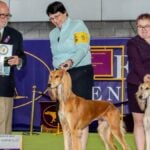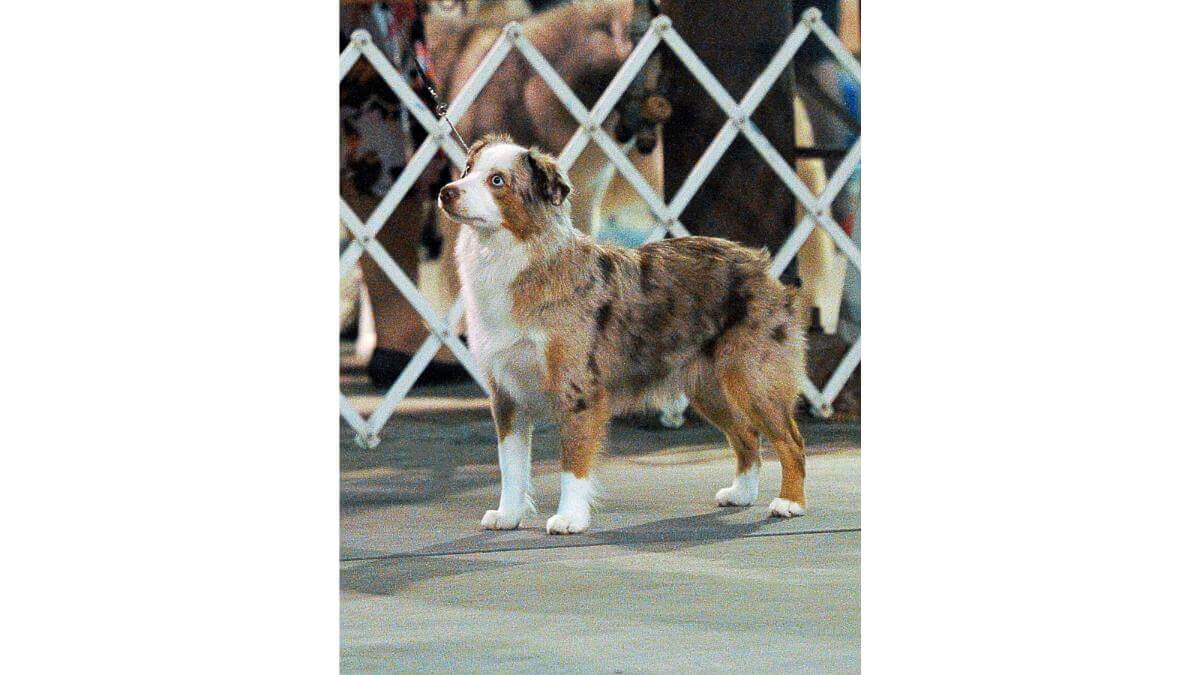


Home » The Miniature American Shepherd

This article was originally published in Showsight Magazine, June 2015 issue.
Although new in its breed name, the Miniature American Shepherd is no stranger across this Nation as well as into Canada and Europe. It was formerly known as the Miniature Australian Shepherd and also called the North American Shepherd. In 1990, MASCUSA, Miniature Australian Shepherd Club of the USA, was formed as the parent club to preserve, promote and protect this lovely breed, eventually bringing them into the fold of the American Kennel Club. Since we were entering into AKC as a new breed, what better time to give our dogs an honest name. The club membership as a whole selected the name Miniature American Shepherd for a breed that truly originated in the United States. So, often you will see the phrase, “Proud to be an American” used to express the pride we have in the accomplishments of this breed. The first impression is that of a small sized herding dog that is slightly longer than tall.
The word moderate seems to be a key word no matter what individual piece of the dog is being evaluated. Our dogs need to have strength and stamina to do their jobs but the word strength is never to be confused with a bulky, heavy muscled body style. This highly versatile, energetic dog makes an excellent athlete. He has superior intelligence and a willingness to please those to whom he is devoted. The size range for dogs is 14 inches up to and including 18 inches at the top of the withers. Bitches are slightly smaller at 13 inches up to and including 17 inches. Although there is a considerable variance between the bottom and top measurements, the prime consideration should be given to the exhibit that most closely meets the Breed Standard. There is NO preference in size within the allowed range. The breed is neither exaggerated nor extreme in any way, exhibiting moderate bone proportionate to their size. The structure of a male reflects masculinity without coarseness. The females will appear feminine without being slight of bone.
Thickness of coat goes a long way in adding to or detracting from the amount of bone/substance that an animal appears to have. It is what is under the hair that should carry the most weight. Moderation is the overall impression of the coat. Hair is of a medium texture, may be straight to wavy, weather resistant and of medium length. Again, the amount of undercoat will vary depending on the seasons and the climate. Hair is short and smooth on the head and front of the legs. The backs of forelegs and breeches are moderately feathered. There is a moderate mane and frill more pronounced in dogs than bitches. Keeping the breed “natural” is a priority, therefore, care was taken to include in the standard that hair may be trimmed only on the ears, feet, back of hocks, pasterns and tail. Also, untrimmed whiskers are preferred. The head is clean-cut, dry and in proportion to the body. The eyes are almond shaped, set obliquely, neither protruding nor sunken and in proportion to the head. Eye colors come in a wide range and may have different color eyes on the same dog. Brown, blue, hazel, amber, including flecks and marbling are acceptable in all coat colors. Eye rims and nose leather corresponds to the base color, i.e., Black base color has black pigmentation and red base color has liver pigmentation.
Ears are triangular, moderate size, set high on the head and may break forward and over or to the side as a rose ear. There is no preference to style, however, prick ears or ears hanging with no lift is a severe fault. The width and length of the crown are equal. The length of the muzzle is equal to the length of the crown. When viewed from the side, the muzzle and top line of the crown are slightly oblique to each other with the front of the crown on a slight angle downward toward the nose. There is a moderate but defined stop. The teeth meet in a scissor bite but broken, missing or discolored by accident are not penalized. A great deal of importance has been given to the description of the head, not for aesthetics but for the safety and function of the dogs still doing the job they were bred to do. Bulging eyes can be subject to injury while working stock. Eyes too small could impair vision. Proper muzzle length is necessary in order to grip stock. The slightly oblique planes would help to allow a kick to glance off the head.
Dogs in the field are subject to sunburn without proper pigmentation on the nose and around the eyes. Lack of color on the nose should be faulted to the extent of deviation up to 50% at which time it becomes a disqualification. The Miniature American Shepherd is examined on the table. The overall structure should give the impression of depth and strength without bulkiness. The loin is strong and broad when viewed from the top. The chest is full and deep, reaching to the elbow, with only a moderate tuck-up. As a breed with height disqualifications, it is important that we maintain balance with the elbow joint being equidistant from the ground to the withers. Measuring from the point of the shoulder to the point of the buttocks and from the highest point of the shoulder blade, he is slightly longer than tall. Judges should keep this in mind and award correct balance. The recognized coat colors are black, blue merle, red, red merle with NO order of preference. Asymmetrical markings or lack of markings are not to be faulted. The standard lists exactly where and what shades in great detail. What is important to remember is that structure comes first and color is secondary with the exception of faults and disqualifications. We are looking for a smooth and effortless side gait with the head carried in a natural position; the neck extended forward and the head nearly level or slightly above the top line.
We do not want to put too much emphasis on side gait alone. Equally important is that the fore and hind legs move straight and parallel converging toward the center line of gravity. Traveling with the head held high is not an efficient gait for the work expected of these dogs. The Miniature American Shepherd is an intelligent, versatile working dog of strong herding and guardian instincts. An exceptional companion, he is easily trained, performing his assigned tasks with great style and enthusiasm. Although reserved with strangers, he does not exhibit shyness. As a herding breed, it is natural for our dogs to be watchful of their surroundings. They may be attentive to their handler, though seemingly not interested in other people. Being watchful does not indicate being fearful, just a pause while sizing up the stranger. Considering the above we would ask judges not to expect statuette style baiting. Assess alertness by the interest in their handler and the surroundings. Please do not throw items to get expression.
Allow the dog to see you coming and try to avoid staring directly into their eyes. All of that said, we fully expect the dogs to be approachable and confident in the ring. Do not be afraid to excuse a dog or to keep it out of the points because of poor temperament!
The following are considered to be of such importance that it warrants a Disqualification:
The Miniature American Shepherd is truly a breed where one dog can do it all.